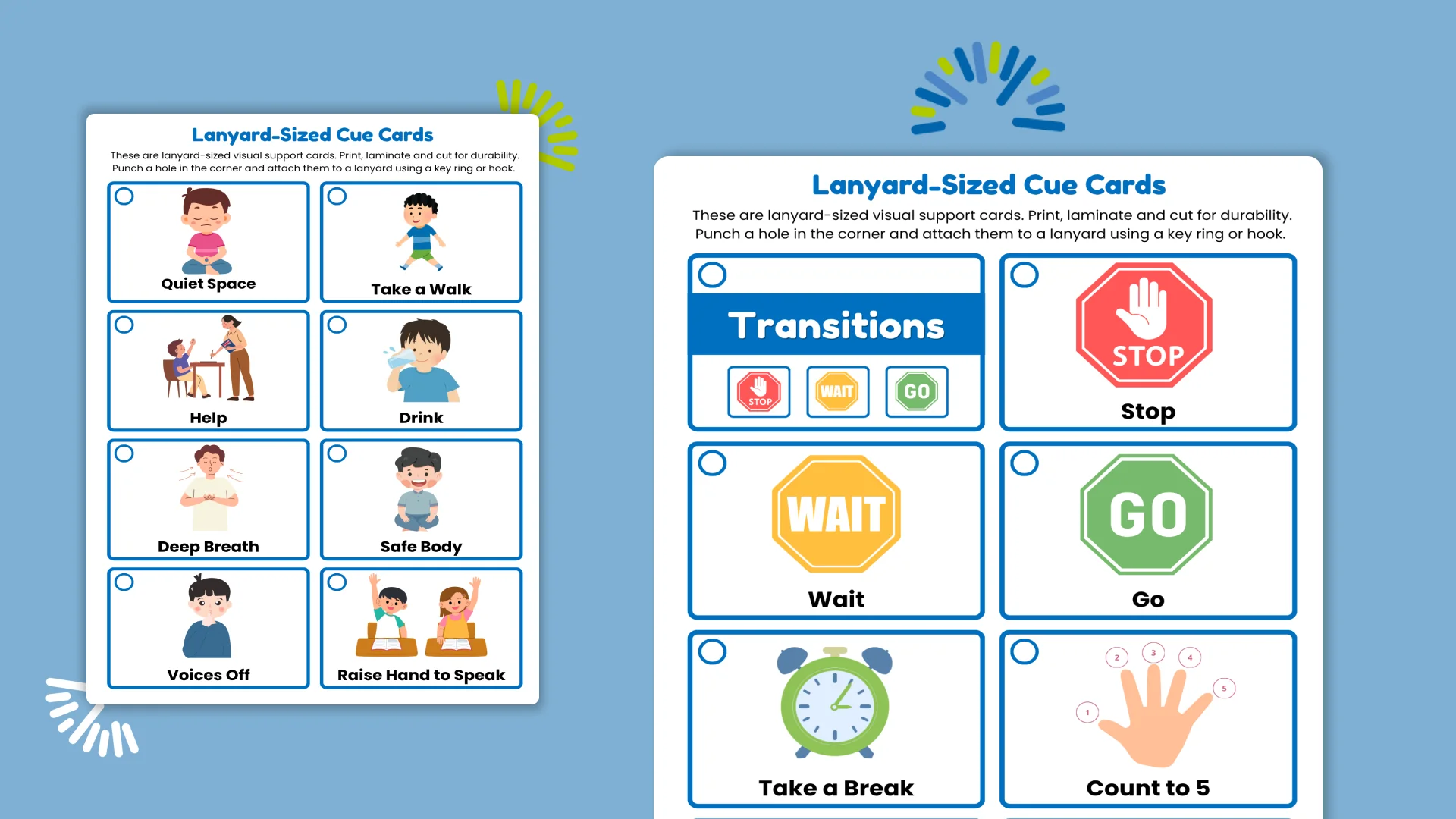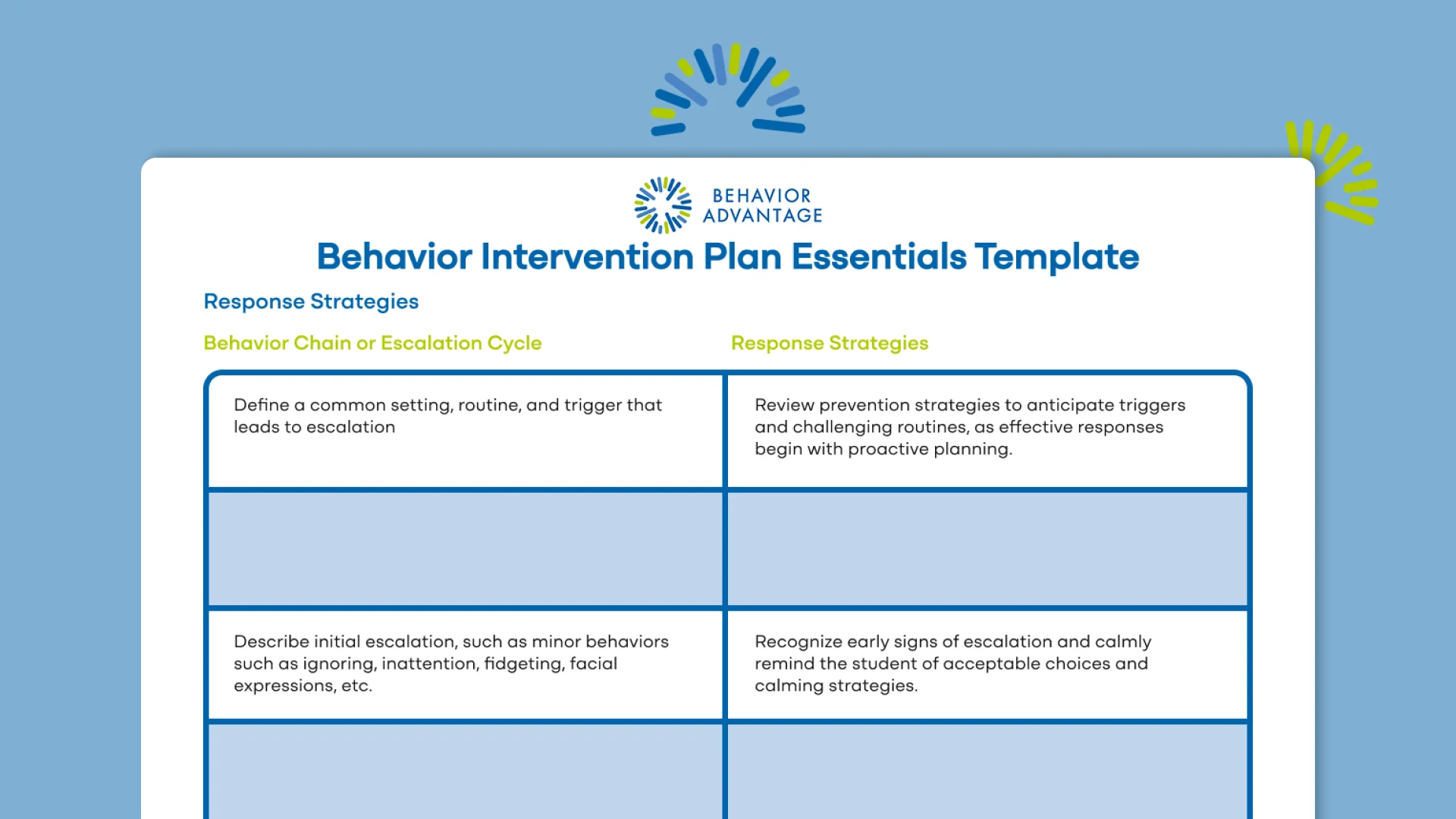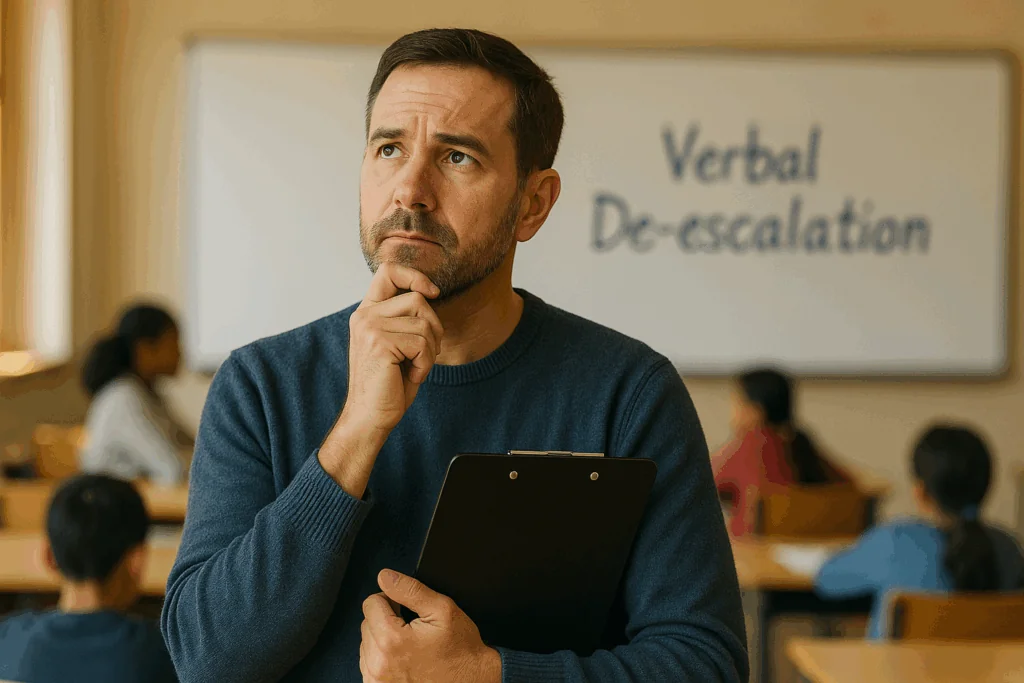Even the best prevention plans can’t stop every tough moment. Teachers know this all too well. You can have a solid Tier 1 foundation – clear expectations, routines that run like clockwork, and positive reinforcement front and center – and still have a student walk in carrying the weight of a rough morning or a sleepless night.
Sometimes it’s bigger than the classroom: friendship drama on the bus, stress at home, or just waking up on the wrong side of the bed. Those invisible factors show up in behavior. That’s why our first line of defense is always connection- greeting students by name, noticing when something’s off, and building a culture where kids feel safe and supported.
But even with all that in place, there are moments when emotions boil over. That’s when verbal de-escalation becomes the teacher’s most powerful tool.
What We Mean by “Verbal De-escalation”
Verbal de-escalation is simply the practice of using your words – and your presence – to help a student calm down before things spiral.
It’s not about having the perfect script. It’s about staying steady yourself, choosing language that signals safety, and helping students regain enough control to re-engage in learning.
In short: when emotions go up, we keep ours down.
Practical Shifts That Change the Energy Fast
Here’s what works in the heat of the moment: simple, doable strategies you can lean on right away.
Listen First. Put aside the clipboard, make eye contact, and let them talk. Sometimes just feeling heard is enough to lower the temperature.
Show Empathy. A quick “I can tell you’re frustrated” goes much farther than “Calm down.” It shows you see their feelings, not just the behavior.
Mind Your Body Language. Your posture speaks before your words do. Keep an open stance, relaxed shoulders, and stand at a slight angle rather than face-to-face to reduce the sense of confrontation.
Lean on Non-Verbal Cues. Whole-class signals such as a raised hand, a quiet pause at the front of the room, or flicking the lights once can prompt attention without calling anyone out or raising your voice.
Keep Your Voice Low and Steady. Use short, calm sentences that invite cooperation instead of resistance. Lowering your tone often makes students lean in.
Focus on Feelings. There’s usually a fear, frustration, or embarrassment sitting underneath the behavior. Naming it often diffuses more than debating the facts.
Co-Regulate in the Moment. Students often borrow the adult’s emotional state. By slowing your breathing, keeping a relaxed posture, and modeling calm responses, you help their nervous system settle alongside yours. This step is just as powerful as anything you say.
Set Gentle Limits. State what’s okay and what’s not, without ultimatums, sarcasm, or a raised voice.
Offer Small Choices. “Do you want a quick stretch or a sip of water before we try again?” Restoring even a little control helps students lower their guard.
These shifts – especially when paired with predictable non-verbal signals – give both teachers and students a sense of stability and predictability during tense moments.
Download our free De-escalation Cue Cards

When It’s the Whole Class, Not Just One Student
Every teacher has felt the shift: side chatter gets louder, a few students start pushing back, and suddenly the room feels edgy. That’s when whole-class de-escalation saves the day.
Why it matters: when the group energy ramps up, little disruptions can snowball fast. Addressing the class as a whole helps everyone reset before things get out of hand.
Tried-and-true strategies:
- Lead With Your Calm. Students mirror your energy; your steady voice and body language say, “We’ve got this.”
- Name the Shift Out Loud. “I can hear the volume picking up – let’s all take a breath together.”
- Use Silent Signals. A hand raised, lights flicked, or a pause at the front of the room often says more than words.
- Lower Your Voice Instead of Raising It. Quiet tones invite students to lean in.
- Offer Collective Choices. “We can dive in now and finish early, or pause for one minute to reset – your call.”
- Catch Them Doing It Right. “I see this table already has their materials out – love that. That helps us all get started smoothly.”
- Try Quick Calming Breaks. A 60-second breathing stretch or a soft-voice countdown can pull everyone back to baseline without losing teaching time.
Individualized Supports: When One Size Doesn’t Fit All
Sometimes classroom-wide strategies just aren’t enough. A few students may need more than reminders and a calm tone to stay regulated. Their behavior might have become more intense or persistent, requiring something more structured – like Tier 2 or Tier 3 supports, an IEP with a Behavior Intervention Plan (BIP), or even a short-term crisis response plan for a new student while the team gathers more information.
That’s when teamwork really matters. The classroom teacher, administrator, counselor, and specialists work side by side to:
- Define the specific behaviors everyone is watching for
- Identify early warning signs and triggers
- Agree on consistent verbal de-escalation strategies that match the student’s level of escalation or presenting behavior
- Pair prevention strategies with skill-building so progress lasts
Download our Crisis Response Plan Template

From Classroom Strategies to Individualized Plans
Verbal de-escalation doesn’t stop being useful just because a student’s needs become more intensive – if anything, it becomes more targeted and deliberate.
What starts as a whole-class approach – steady tone, calm language, clear boundaries – shifts into a personalized playbook written right into the student’s BIP or crisis response plan. This makes sure every adult knows exactly:
- When to use each prompt
- How to phrase it
- How to respond as the student moves through the stages of the escalation cycle
That shift is what keeps things consistent. Instead of hoping everyone is on the same page, the plan spells it out. The familiar strategies that work at the classroom level become individualized steps that guide the whole team through tough moments – keeping students supported and staff confident.
Let’s pull it together by walking through examples of verbal de-escalation at each stage of escalation. You’ll see what student behavior might look like alongside the verbal de-escalation strategies that work best in the moment. The key takeaway: having a clear plan keeps every adult consistent and steady – even in tense situations.
The Behavior Escalation Cycle: Using Verbal De-escalation at Every Stage
Challenging behaviors rarely happen out of the blue – most follow a predictable cycle.
Knowing the stages – and how to adjust your words, tone, and even your non-verbal responses at each one – helps adults create the conditions for the student to co-regulate in the moment, guiding them back to calm, instead of reacting on impulse.
Think of verbal de-escalation as a flexible tool: the way you speak (and sometimes what you don’t say) shifts to meet the student where they are.
1. Trigger: Spot It Early, Keep It Low-Key
Students often send subtle signals – sighs, muttering, clenched fists – that they’re starting to feel overwhelmed. This is your best window to step in before things escalate.
Example:
During the transition from recess back to class, Jordan lingers at the door, shoulders tense and fists clenched, mumbling, “I don’t want to do math right now.”
Prevention Strategy with Verbal De-escalation:
“Jordan, I can see it’s hard to switch gears after recess. Take a minute to get a drink of water, then we’ll get started together on the first problem.”
✅ Why it works:
Names the challenge (the hard transition), offers a brief regulation break, and guides the student back to the task without a power struggle. Catching the trigger early prevents the transition stress from turning into refusal or outbursts.
2. Initial Escalation: Drop the Volume, Avoid the Power Struggle
If the trigger isn’t addressed, students may protest louder or push back. At this point, your words – and especially your tone – can either cool things down or pour fuel on the fire.
Example:
Sam slams his book: “I’m not doing this!”
Verbal De-escalation:
“I can see you’re frustrated. Take a quick stretch or water break. When you’re ready, we’ll look at it together.”
✅ Why it works:
Empathy plus choice signals respect and gives the student an off-ramp without losing face.
3. Increased Escalation: Fewer Words, Calmer Voice
At this stage, behaviors may include yelling, pacing, or slamming objects. Students are often too activated to process long explanations.
Verbal de-escalation here means using fewer words, slowing your pace, lowering your voice, and leaning on non-verbal supports. This is where a non-verbal cue card – like a pre-taught “Take a Break” or “Calm Corner” card – can guide students without more verbal input.
Example:
Jordan shouts while shoving his chair back: “I said I’m not doing this!”
Verbal De-escalation:
“Jordan, let’s pause on that task. You can use the calm space or walk to the fountain.”
Non-Verbal Support:
Quietly hold up the “Calm Space” cue card or gesture toward the designated calm area.
✅ Why it works:
Short, calm verbal directions reduce power struggles.
A visual cue card provides clear next steps when words feel overwhelming.
Non-verbal prompts reduce demands on a dysregulated student’s processing, keeping the adult’s tone neutral and consistent.
👉 Tip: Keep laminated cue cards on a lanyard, clipboard, or near the calm space so they’re ready at a moment’s notice.
4. Target / Unsafe Behavior: Safety First, Keep Language Minimal
At peak escalation, reasoning and teaching can wait – safety comes first.
Example:
Rosa kicks her chair over after being redirected.
Verbal De-escalation:
“Rosa, walk to the calming corner and take a break.”
✅ Why it works:
The fewest words possible in a calm tone help guide Rosa to safety without escalating further.
5. Recovery: Gentle Words to Re-Engage, Not Re-Trigger
As students begin to settle, they’re still vulnerable. Moving too fast into problem-solving or discipline can restart the cycle.
Example:
After an outburst, Alex sits quietly with his head down.
Verbal De-escalation:
“I’m glad you’re feeling calmer. Take a few more minutes. We’ll talk about what you need when you’re ready.”
✅ Why it works:
Acknowledges the student’s effort to calm down and signals that they’re safe before any discussion about what happened.
The Recovery Phase: Don’t Rush It
This stage is where relationships can be rebuilt. Once calm, acknowledge the effort they showed in regaining control. Later – often privately – have a restorative conversation about triggers, what worked, and what strategies could help next time.
Why Planning Ahead Changes Everything
Verbal de-escalation works best when every adult knows the plan and uses the same calm language and visual cues at each stage.
A strong response strategy plan should:
- Prioritize safety for everyone
- Preserve dignity for the student
- Support independence and skill-building
- Make re-entry to learning smooth and predictable
When staff share common words, tones, and non-verbal prompts, students feel safer – and tense moments become more manageable.
Final Thought: The Power of Verbal De-escalation
Verbal de-escalation isn’t just a crisis response – it’s a general strategy for building safer, calmer classrooms every day.
It’s about the words we choose, the tone we set, and the signals we send that tell students: “You’re safe here. We can handle this together.”
The real power of verbal de-escalation is in consistency.
When every adult on the team knows the plan, uses the same calm language, and pairs it with predictable non-verbal prompts, students learn that – even in tough moments – the adults around them will stay steady and supportive.
We can’t prevent every challenge or control what students carry with them from outside the classroom.
But we can create conditions that protect safety, lower stress, and build trust – moment by moment, word by word.
That’s the heart of verbal de-escalation:
A steady, team-wide approach that helps students move through escalation with patience, respect, and clarity – so they can return to learning feeling supported, not shamed, and a little more resilient each time.
👉 Ready to put these strategies into action? Explore our Response Strategy & Safety Plan template and Nonverbal Cue Cards to help your team stay consistent across every stage of the escalation cycle. Pair these with the Behavior Advantage platform to document, track, and analyze responses – so your staff can focus less on paperwork and more on supporting students.









